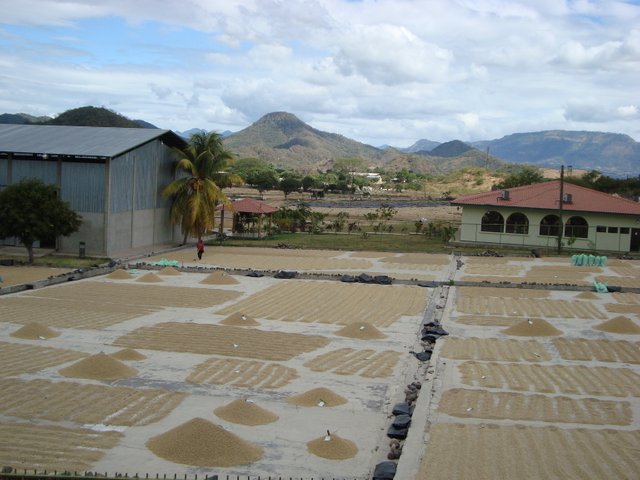Dry milling coffee
Travelling through Nicaragua, on a 20 km stretch (from Sébaco to Matagalpa) I counted over 45 big coffee dry milling facilities by the side of the road. Together they cover over 50% of the capacity needed to process all Nicaraguan coffee. Nicaragua is known for its washed, sun-dried, high altitude quality coffees and between December and May you encounter a lot of places where you can see coffee being dried in the sun on concrete floors (patios) by the dry milling companies.
These dry milling facilities are owned by big producers, cooperatives and/or international exporting companies that finance and buy the washed coffee from the farmers and prepare it for exportation (containers that are dispatched by sea). As such, dry milling facilities are the last step in the local coffee chain of the coffee producing countries, exporting the green coffee beans. The process of toasting and grinding is almost totally done by a few big internationals in Europe and the United States.
But before milling or storing the coffee after receiving it from the farmers, it has to lose a lot of humidity first. You can dry the pergamine or cherries with machines (as is done a lot in Honduras and Costa Rica for instance), but that negatively effects quality, however, not everybody agrees on that. For that reason some coffees advertise as “sun dried”.

PRODECOOP R.L. Nicaragua
That’s a bit of a problem with washed coffee because wet-milling is mostly done in countries with abundant rain fall. What they do is look for local micro-climates with a lot of sunshine: remember the above trip I made in Nicaragua! That was one of those micro-climates. So the farms are found in the mountains where the wet milling is done and dry milling facilities are found in the valleys with a dry micro-climate. They are often located at the side of a big road to facilitate transportation of containers to the ports.
The natural process of drying (mostly used in countries where rainfall is scarce with long spells of sunshine) dries the beans when they are still inside the cherry. This results in coffee with a heavier mouth feel, lower acidity and more typical flavors. Washed coffees appear cleaner, brighter and fruiter with full acidity.
The actual process of dry milling is called hulling: everything but the green coffee bean is removed either by simple milling stones or some more elaborate machinery.
After hulling the coffee, the remaining bits of silver skin is removed by polishing the beans. This is necessary to reduce the chaff when roasting, but it improves appearance as well. Hulling and polishing should be done very carefully as not to raise the temperature too much through friction.
Sorting and cleaning is the next step in dry milling facilities. A lot of this is done by machines that sort, shake and blow the coffee, but the final step of fine and quality coffees is done by hand. Cleaning, size and density (weight of the beans) sorting can be done easily by machines, but in most coffee producing countries labor intensive forms are preferred over capital intensive ones. Moreover, there are some things humans can do better and easier like color-picking or separate special types of beans. The “caracol” bean is an example of the last: small, round beans that have no fully opened fissure and sometimes special requests are made for this kind of bean.
The last step, before packaging and exporting is called grading. This is the categorizing of the beans on various criteria. That can be the size of the bean, altitude it was grown, its origin (traceability), or its quality in the cup. Bigger facilities almost always have a laboratory for quality control and cupping. As a matter of fact, cupping laboratories are a pre-requisite for quality and specialty coffees, as we will see in another theme of this series.
Packed in bags the coffee is transported in containers to the nearest seaport.
Previous article from coffee series you can find under tag #cafescope.
You can see them all here.
Article was also published on Cafescope
cute your post, please follow me and if you want to comment my post 😁👍
what is the name of your best coffee in your place? as in my country Indonesia we have Luwak white coffe and so on
Posted using Partiko Android
Nicaragua famos brand is Café Dipilto
I love coffee and maybe I can find it in ebay or somewhere else. Thank you
Posted using Partiko Android